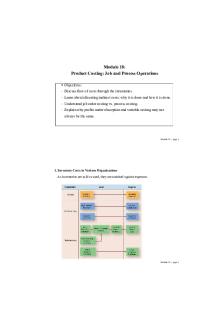Lecture 18 PDF

| Title | Lecture 18 |
|---|---|
| Course | Chemistry 2 |
| Institution | Florida State University |
| Pages | 1 |
| File Size | 36 KB |
| File Type | |
| Total Downloads | 106 |
| Total Views | 150 |
Summary
This is Dr. Dillon's lecture on weak acids and bases as well as polyprotic acids. The majority of her lecture were problems, but some were content and vocab. Hope it helps!...
Description
Lecture 18.1 Dillon CHM1046 Weak Acids and Bases that exist in equilibrium Weak Acids and bases only partially dissociates unlike strong ones which dissociate fully and does not exist in equilibrium Ka and Kb Values Ka is the equilibrium constant for bases and the Kb value is for the bases Ionization constants are the measure of the strengths of acids and bases. The larger the Ka or Kb, the stronger the acid or bas, respectively. K The only thing that can change to the constant is temperature. The rules for equilibrium constants apply to the dissociation of acids and bases Weak acids only ionize to a small extent and come to a state of equilibrium. You can calculate the equilibrium [] the same way as the other equilibrium problems. Problem solving approach 1. Write a balanced equation (ALWAYS THE FIRST THING) 2. Write an expression for Ka 3. Define x as the change in concentration that occurs during the reaction 4. Construct a reaction table in terms of x 5. Male assumptions that simplify the calculations 6. Sub. Values into the Ka expression and solve for x 7. Check that the assumptions are justified
Lecture 18.2 Polyprotic Acids – acids that accept/donate multiple protons. An acid with one ionizable proton. This goes through dissociation through a step wise process. Ka1 > Ka2> Ka3. Because Ka1 is larger, it means that it contributes to the donation of protons to the solution the most. The rest following are VERY weak acids. In Ka2 and Ka3 it can sometimes be negligible. What is the pKa? It is the negative log of the Ka. This is a way for us to work with the numbers that are really small to identify if an acid or base is weak or strong. The LOWER the pKa value the stronger the acid....
Similar Free PDFs

18 - Lecture notes 18
- 5 Pages

Lecture 18
- 1 Pages

Lecture 18
- 6 Pages

Chapter 18 - Lecture notes 18
- 21 Pages

Chapter 18 - Lecture notes 18
- 14 Pages

Module 18 - Lecture notes 18
- 41 Pages

Chapter 18 - Lecture notes 18
- 26 Pages

Chapter 18 - Lecture notes 18
- 13 Pages

Research 18 - Lecture notes 18
- 5 Pages

Lecture notes, lecture 1-18
- 26 Pages

9 18 18 Ipats - Lecture notes 4
- 3 Pages

Chapter 18 - Lecture 1
- 37 Pages

Lecture 18 - Medieval Synthesis
- 4 Pages
Popular Institutions
- Tinajero National High School - Annex
- Politeknik Caltex Riau
- Yokohama City University
- SGT University
- University of Al-Qadisiyah
- Divine Word College of Vigan
- Techniek College Rotterdam
- Universidade de Santiago
- Universiti Teknologi MARA Cawangan Johor Kampus Pasir Gudang
- Poltekkes Kemenkes Yogyakarta
- Baguio City National High School
- Colegio san marcos
- preparatoria uno
- Centro de Bachillerato Tecnológico Industrial y de Servicios No. 107
- Dalian Maritime University
- Quang Trung Secondary School
- Colegio Tecnológico en Informática
- Corporación Regional de Educación Superior
- Grupo CEDVA
- Dar Al Uloom University
- Centro de Estudios Preuniversitarios de la Universidad Nacional de Ingeniería
- 上智大学
- Aakash International School, Nuna Majara
- San Felipe Neri Catholic School
- Kang Chiao International School - New Taipei City
- Misamis Occidental National High School
- Institución Educativa Escuela Normal Juan Ladrilleros
- Kolehiyo ng Pantukan
- Batanes State College
- Instituto Continental
- Sekolah Menengah Kejuruan Kesehatan Kaltara (Tarakan)
- Colegio de La Inmaculada Concepcion - Cebu


